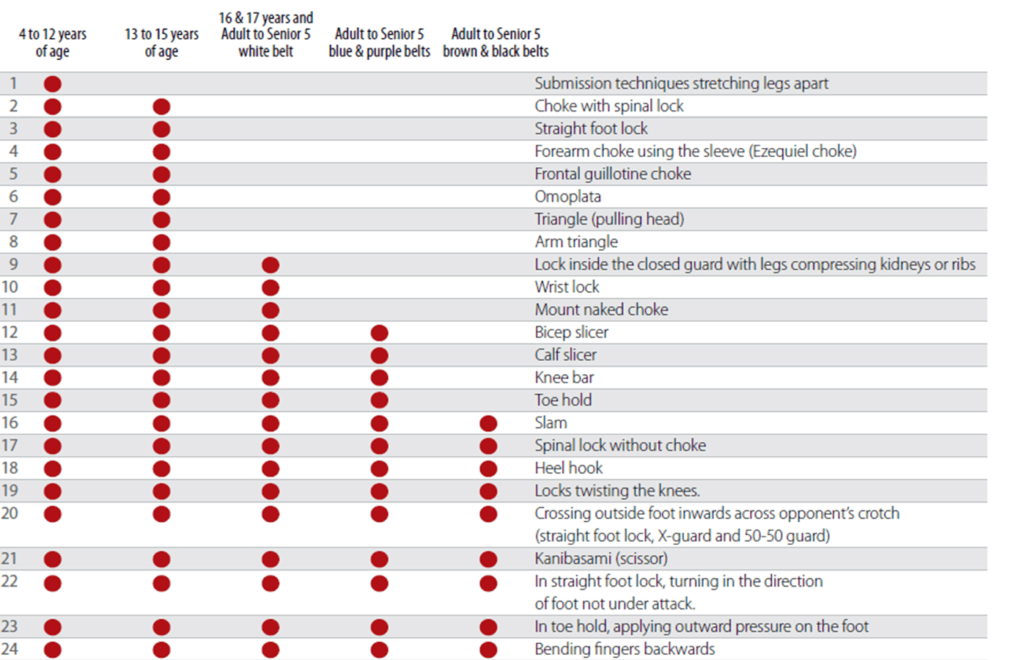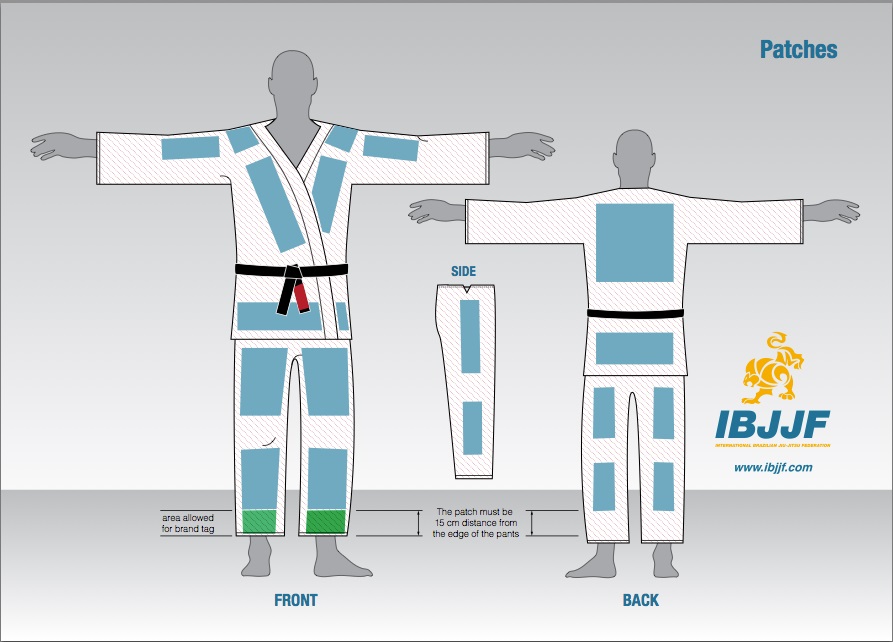The IBJJF rulebook is long, confusing and ain’t nobody got time for that. Most people know the key rules and they go at it on the mats. That’s why we’re here to help! We’ve condensed the IBJJF rulebook down into this quick and easy, digestible guide, which you can use when you’re on the go to tell that referee “I wasn’t reaping the knee, he moved my foot!”
IBJJF Scoring System
There are numerous ways to win under the IBJJF ruleset, the main ones are outscoring a fellow competitor by points or winning by submission. We go deeper into how you can win your next match under the IBJJF ruleset.
Points
The IBJJF and many other BJJ rulesets determined a points system to decide a winner when no submission was called during the allotted time. Please note Side Control is not a scoring position, but the act of passing the guard, or sweeping to Side Control, scores. Points are scored after the position is held and controlled for 3 seconds.
- 4 Points – Mount, Back Control
- 3 Points – Passing The Guard
- 2 Points – Knee on Belly, Sweeping from Guard, Takedowns from Standing
Advantages and Penalty points can also be scored during a match, these are determined as follows.
Advantages
An advantage is scored when a fundamental move is initiated but not fully completed, this could be a submission, sweep, take down or passing attempt. If a match ends in a draw on points then advantages are taken into consideration to determine a winner.
- Takedown advantage – An advantage is scored with a takedown when there is a visible loss of balance, or the takedown is completed outside of the designated area.
- Guard passing advantage – If the player on top is passing the guard and the player underneath stops the pass by turtling, an advantage is awarded as the pass was not fully completed.
- Sweeping advantage – If a player in guard attempts a sweep, which was almost completed, an advantage may be awarded depending on how close that sweep was to be finished.
- Submission advantage – If a submission is attacked, which causes a player to defend, the attacker will be scored an advantage if they are unable to complete the submission.
Submissions
A submission is when a technique is applied, ie a chokehold or joint lock, which causes another player to admit defeat through the following:
- Physical tapping – If the defeated player taps the mat or the other competitor with their hands or feet, that is considered a submission.
- Verbally tapping – If a competitor verbally says they are defeated, i.e verbally saying tap, crying out in pain, etc. then they admit defeat.
- Unconsciousness – If a competitor falls unconscious during the fight due to a chokehold or by other means, that is an automatic submission loss.
- Throw in the towel – If a coach decides to throw in the towel and call an end to the match, that is considered a loss for the competitor.
- Referee’s digression – If a referee sees that one competitor is likely to be seriously injured during a submission hold, they can stop the match and award the win.
- Requesting a timeout due to pain – If a timeout is requested due to pain, that is considered a verbal submission. This is also down to referee’s discretion, i.e if someone was kicked in the genitals.
IBJJF Fouls
As well as winning, you can also lose through the IBJJF ruleset, penalties and disqualifications are also awarded to competitors, so make sure you’re savvy about this section of the rules.
Penalties
If a match is going nowhere a referee will often award penalty points to get the action going again, if a match ends in a tie on points then penalties are taken into consideration when deciding a winner. Penalties are awarded by referees, again discretion is advised. These can come in the form of penalty points for the first offence, advantages for a second offence, or additional points for competitors for a third offence.
- Not engaging – If a player sits to guard without engaging their opponent, i.e holding onto their kimono jacket, they are awarded a penalty.
- Illegal grips – If a player is seen inserting their fingers inside the sleeve of the trouser leg to control their opponent, then they are penalised.
- Communication – If an athlete communicates with their the other competitor or the referee, that is considered a penalty.
- Face pushing – If a player pushes the face of their opponent, with their hand or foot that is considered illegal.
- Taking a rest – If a player takes off their jacket, takes too long to tie their belt or does anything to intentionally stall to take a breather, that is illegal.
- Stalling – If either player is considered stalling, i.e. not pushing the action on, then that is considered a foul.
Disqualification
A disqualification can happen when a serious foul is committed or if one player racks up too many penalties and the referee wants to end the match. Let’s look a bit more into how to get disqualified
- Fleeing – If a competitor flees the bounds of the matted area, either to avoid a sweep, takedown or submission attempt, that is considered a penalty.
- Physical violence – If punches, kicks or any form of physical violence occurs, then a player is immediately disqualified
- Slams – If a player attempts to slam their opponent into the ground, to either break a submission or open the guard then that is an immediate DQ
- Disrespect – If athletes use any foul language on the mats, towards their competitor, the referee, the coaches or anyone else, that is a disqualification
- Reaping – If an athlete is seen reaping the knee of an opponent, by either moving themselves into position or moving their opponent into an illegal position, they are automatically DQed
- Illegal uniform – If a uniform does not meet requirements during the competition, then a player is automatically disqualified
- Illegal submission – If a submission is attacked which is deemed illegal for their level, then the match is immediately ended. Below is the list of legal and illegal moves for all ages and belt levels. Study them and make sure you know what you can and can’t use.

IBJJF Hygiene Rules
In order to compete under the IBJJF ruleset, you must have good hygiene, common sense right? Well sometimes little things get looked over and these little things could mean you stepping on the mats or getting DQed before even getting into the bullpen. Make sure you have these things covered before you even leave the house
- Trimmed nails – Make sure all your finger and toe nails are trimmed before stepping onto the mats. Long nails can cause cuts and scrapes that no-one needs.
- Clean kimono – Make sure that your kimono or clean and dried before competing.
- Unpleasant smells – If you or your gi has any unpleasant smells, make sure to get that sorted before stepping onto the mats.
- Temporary hair dye – Athletes are not permitted to colour their hair with hair paint before the match as sweat will cause the paint to leech out.
IBJJF Uniform Requirments
The IBJJF has some strict rules on gi sizing, patch placement and quality standards. Kimono requirements are probably the main thing that busts a number of competitors. So make sure these are sorted.
Kimono
Having a proper Jiu-jitsu gi is everything when you’re competing under IBJJF rulesets. Do you want to know why there are so many kimono vendors at the competition? It’s so you can grab a new one just in case your gi isn’t regulation. Let’s delve into what that means.
- Material – A BJJ competition gi should be constructed with a weaved cotton fabric. Ripstop or canvas jackets are not allowed under the IBJJF ruleset. The material must not be too thick or hard, that it will impede other competitors. Trousers must be either a drill cotton or ripstop material, no denim or nylon materials are allowed.
- Sizing – A BJJ gi jacket must be a sufficient length down the thighs of a competitor and the jacket sleeves much reach the wrists of a competitor when the arms are outstretched forward and to the side. Trousers must reach the ankles of a competitor and must not be too slim fitting.
- Quality – The jiu-jitsu gi must not have any rips, tears or compromises in its construction.
- Colour – The IBJJF require that competitors wear either a white, blue or black gi. No other colours are permitted.
- Patches – There are specific requirements when it comes to kimono patch placement. Please look at the image below for a detail explanation.

Belt
- Colour – A BJJ belt must be the same colour as the division that you are competing in.
- Sizing – A regulation belt must be long enough to allow for sufficient lengths at the end of the knot. The width of the belt must also be between 4 and 5cm
- Grading bar – In all IBJJF competitions, a grading bar must be present on the belt.
- Tied – a BJJ belt must be sufficiently tied around the waist in order to keep the kimono jacket closed
Overall these are a quick rundown of the IBJJF ruleset, If you want to delve deeper into the rules, you can look at them here. Or check out the video below.
